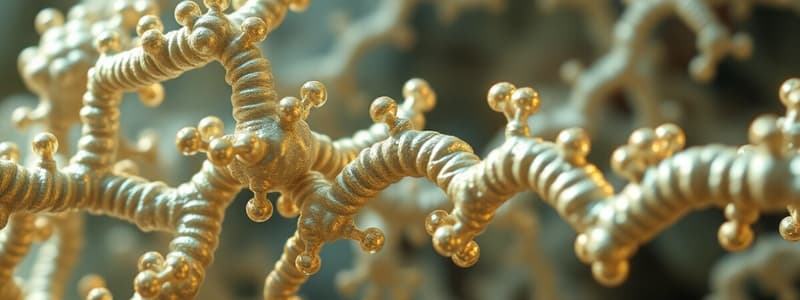Podcast
Questions and Answers
What does Dalton's Law of Partial Pressure state about the total pressure in a mixture of gases?
What does Dalton's Law of Partial Pressure state about the total pressure in a mixture of gases?
- It is equal to the volume of the gases combined.
- It is determined by the highest partial pressure among the gases.
- It is equal to the sum of the partial pressures of the individual gases. (correct)
- It is the product of the densities of the gases.
How is the partial pressure of a gas calculated?
How is the partial pressure of a gas calculated?
- By converting the gas concentration into a percentage and dividing by the total pressure.
- By multiplying the fractional concentration of the gas by atmospheric pressure. (correct)
- By taking the square root of its molar mass and multiplying by atmospheric pressure.
- By summing the volumes of all gases present in the mixture.
What is the partial pressure of O2 when delivered at sea level in a 30% O2 mixture?
What is the partial pressure of O2 when delivered at sea level in a 30% O2 mixture?
- 228 mm-Hg (correct)
- 160 mm-Hg
- 760 mm-Hg
- 300 mm-Hg
If the atmospheric pressure is 550 mm-Hg, what is the partial pressure of O2 in that environment?
If the atmospheric pressure is 550 mm-Hg, what is the partial pressure of O2 in that environment?
What is the partial pressure for N2 in the atmosphere at sea level?
What is the partial pressure for N2 in the atmosphere at sea level?
What is the primary purpose of carbohydrates in the body?
What is the primary purpose of carbohydrates in the body?
Which type of carbohydrate contains a ketone functional group?
Which type of carbohydrate contains a ketone functional group?
What defines a monosaccharide?
What defines a monosaccharide?
In Fisher projections, how are horizontal and vertical lines represented?
In Fisher projections, how are horizontal and vertical lines represented?
What is the ratio of oxygen to hydrogen in carbohydrates?
What is the ratio of oxygen to hydrogen in carbohydrates?
Which classification of carbohydrates includes those made of many sugar units?
Which classification of carbohydrates includes those made of many sugar units?
What do Lewis dot structures illustrate?
What do Lewis dot structures illustrate?
Which of these describes a characteristic feature of simple carbohydrates?
Which of these describes a characteristic feature of simple carbohydrates?
What is the role of amino acid side chains in enzyme function?
What is the role of amino acid side chains in enzyme function?
Which enzyme system is known as the 'mixed-function oxidase system'?
Which enzyme system is known as the 'mixed-function oxidase system'?
What effect does an inducer have on an enzyme-catalyzed reaction?
What effect does an inducer have on an enzyme-catalyzed reaction?
What is the primary metabolic action of Pseudocholinesterase?
What is the primary metabolic action of Pseudocholinesterase?
How does grapefruit juice affect drug metabolism?
How does grapefruit juice affect drug metabolism?
Which type of receptor is primarily responsible for transmitting signals via GTP?
Which type of receptor is primarily responsible for transmitting signals via GTP?
What occurs when the M2 receptor is inhibited in the SA node?
What occurs when the M2 receptor is inhibited in the SA node?
What is a significant characteristic of the fluidity of the cell membrane?
What is a significant characteristic of the fluidity of the cell membrane?
Which enzyme is involved in converting a prodrug to its active metabolite?
Which enzyme is involved in converting a prodrug to its active metabolite?
What happens to metabolism in a patient who is both acidic and hypothermic?
What happens to metabolism in a patient who is both acidic and hypothermic?
What happens to temperature when pressure is decreased in a gas system?
What happens to temperature when pressure is decreased in a gas system?
What is the primary reason for the drop in pressure observed when the nitrous oxide cylinder is at 1/4 full?
What is the primary reason for the drop in pressure observed when the nitrous oxide cylinder is at 1/4 full?
Which method is used to accurately measure the amount of N2O remaining in a cylinder?
Which method is used to accurately measure the amount of N2O remaining in a cylinder?
What is the molecular weight of nitrous oxide (N2O)?
What is the molecular weight of nitrous oxide (N2O)?
How long will a full nitrous oxide cylinder last if 2 liters are administered per minute?
How long will a full nitrous oxide cylinder last if 2 liters are administered per minute?
Why can PSI gauges on N2O cylinders not be relied upon as they are for O2 cylinders?
Why can PSI gauges on N2O cylinders not be relied upon as they are for O2 cylinders?
What is the weight of the N2O in a full cylinder given that its full weight is 5.6 kg and the tare weight is 4.5 kg?
What is the weight of the N2O in a full cylinder given that its full weight is 5.6 kg and the tare weight is 4.5 kg?
According to the Joule-Thompson effect, what occurs when a compressed gas is allowed to escape freely into space?
According to the Joule-Thompson effect, what occurs when a compressed gas is allowed to escape freely into space?
What happens to the pressure in a N2O cylinder as it empties?
What happens to the pressure in a N2O cylinder as it empties?
How is the Joule-Thompson effect related to pressure in a constant-volume cylinder?
How is the Joule-Thompson effect related to pressure in a constant-volume cylinder?
According to Avogadro's hypothesis, how many liters does one mole of a gas occupy at STP?
According to Avogadro's hypothesis, how many liters does one mole of a gas occupy at STP?
What is Avogadro's number?
What is Avogadro's number?
What condition defines the critical temperature of a gas?
What condition defines the critical temperature of a gas?
Which equation represents the ideal gas law?
Which equation represents the ideal gas law?
In a clinical application, how does the pressure in a Bourdon's gauge correspond to gas content?
In a clinical application, how does the pressure in a Bourdon's gauge correspond to gas content?
What occurs in a closed space when a cylinder of compressed gas is opened?
What occurs in a closed space when a cylinder of compressed gas is opened?
Flashcards are hidden until you start studying
Study Notes
Enzyme Function
- Active site on enzymes is the specific area where substrates bind to facilitate reactions.
- Amino acid composition is crucial; side chains determine the enzyme's shape and ability to accommodate substrates.
- Binding of amino acid residues alters enzyme shape, size, and chemical behavior, contributing to the formation of the enzyme-substrate complex.
Cytochrome P450
- Critical enzyme system for metabolizing anesthetic drugs, referred to as the "mixed-function oxidase system."
- Use of anti-seizure medications can induce the CYP450 system, potentially rendering other medications like Rocuronium ineffective.
- Inducers accelerate metabolic reactions, necessitating higher doses of medications such as fentanyl and midazolam for analgesic effect.
- Inhibitors, like grapefruit juice, reduce enzyme activity, enhancing the effects of opioids and benzodiazepines.
Plasma Pathways of Metabolism
- Pseudocholinesterase: Metabolizes succinylcholine, allowing for rapid drug clearance compared to traditional agents like neostigmine.
- Nonspecific Esterase: Rapid metabolism of remifentanil, enabling swift recovery from its effects.
- Alkaline Phosphatase: Converts prodrug Frospropofol into its active form.
- Hoffman Elimination: Reaction rate affected by pH and temperature; for instance, metabolic rates of cisatracurium decrease in acidic, hypothermic conditions.
Cellular Communication
- Extracellular communication occurs via chemical signals (hormones, neurotransmitters), electrical signals (action potentials), and mechanical signals (pressure).
- Cells receive signals through receptors that convert extracellular input into specific intracellular responses.
- Most receptors are membrane-bound, although some exist intracellularly.
Types of Receptors
- Extracellular Receptors: Include ion channels, G-protein coupled receptors, and enzyme-linked receptors.
- Intracellular Receptors: Respond to signals from within the cell.
- Cell membrane, composed of a phospholipid bilayer, enables protein mobility crucial for cellular functions.
G-Protein Coupled Receptors
- These 7-transmembrane receptors transmit signals from extracellular substances to intracellular molecules, activating GTP.
- Ligand binding triggers G-proteins, which can then influence channels, transport, enzymes, receptors, or structural proteins.
- These receptors act to either open/close ion channels or activate/inhibit intracellular enzymes, impacting physiological functions like heart rate.
Carbohydrates
- Carbohydrates are biomolecules primarily composed of carbon, hydrogen, and oxygen, exemplifying a 2:1 hydrogen-oxygen ratio similar to water.
- Classified into simple carbohydrates based on functional groups (ketose, aldose) and by the number of sugar molecules (monosaccharides, disaccharides, polysaccharides).
- Fischer projections provide a means to visualize carbohydrate structures in two dimensions.
Lewis Dot Structures
- Illustrate bonds formed between atoms through valence electrons, aiding in understanding molecular interactions.
Dalton's Law of Partial Pressure
- Total gas pressure is the combined pressure of individual gases in a mixture, assuming no chemical interaction.
- At sea level, partial pressures of O2 (160 mmHg) and N2 (600 mmHg) combine for a total atmospheric pressure of 760 mmHg.
- Partial pressures are calculated by multiplying the gas fraction by atmospheric pressure, assisting in anesthesia calculations.
Avogadro's Number and Hypothesis
- Equal volumes of gases at the same temperature and pressure contain equal particle numbers.
- One mole of gas occupies 22.4 liters at standard conditions.
Cylinders and Gas Principles
- Critical Temperature: The highest temperature at which a gas can exist as a liquid; gas cannot be liquefied above this temperature.
- Adiabatic Processes: Rapid pressure release from gas leads to a temperature increase due to heat conservation.
- Joule-Thompson Effect: Gas expansion under low pressure results in cooling; decreased pressure causes a temperature drop.
Nitrous Oxide Cylinder (N2O)
- Gauge readings do not accurately represent gas quantity as N2O exists as both liquid and vapor.
- Pressure decreases significantly as the tank empties, requiring weight measurements for accurate content assessment.
- Full N2O cylinder weighs approximately 5.6 kg and can provide anesthesia based on predefined weight and flow rate calculations.
Studying That Suits You
Use AI to generate personalized quizzes and flashcards to suit your learning preferences.




